Linksys Hydra Pro 6E (AXE6600) review
Linksys Hydra Pro 6E: Specs
Wi-Fi Spec: AXE6600
Number of Antennas/Removable: 4/No
Ports: 1 WAN/4 LAN gigabit per second, USB 3
Processor/Memory/Storage: Quad-core 1.8GHz/512MB/512MB
Wi-Fi chip: Qualcomm Networking Pro 810
Peak 802.11ac performance: 1.96Gbps (at 15 feet)
Range: 80 feet
Size: 11.0 x 6.7 x 2.4 inches
Estimated Annual Electricity Cost: $11.80
Cost: $500
Seeking to make Wi-Fi 6e routers more affordable and mainstream, the Linksys Hydra Pro 6E (aka MR7500) puts it all together but pales in terms of range and throughput next to the Netgear Nighthawk RAXE500. Still, it’s a great way to take advantage of the router’s ability to move data over the 2.4-, 5- and 6GHz bands, opening up new vistas of performance, and claiming a spot alongside the best Wi-Fi 6 routers. That is, if you have a computer or phone that can take advantage of Wi-Fi 6E’s 6GHz band, which remain few and far between.
It undercuts the RAXE500 by $100 on price and is not only smaller and easier to hide, but offers a slew of customization options that can let you make the router fit your home and its users. In other words, it may not be the fastest or longest reaching router, but the Hydra 6E is Wi-Fi 6E for the rest of us.
Linksys Hydra Pro 6E review: Pricing and availability
The second Wi-Fi 6e router that we’ve seen, the Linksys Hydra Pro 6E (model number MR7500) seeks to balance extra performance with price, making it a high-performance router that puts the emphasis on value. It has a list price of $499 but can be had for as little as $349. It’s a bargain that easily undersells the Nighthawk RAXE500 router.
It comes ready to create a powerful home network with the Hydra 6E’s AC adapter, a Cat 6 cable and a Setup Guide card that’s enough to get going.
Linksys Hydra Pro 6E review: Design
The all black Linksys Hydra Pro 6E can blend in to just about any décor and hide in plain sight on a bookcase or windowsill but has soft rubber feet as well as inserts for hanging on a wall. The router measures 11.0 x 6.7 x 2.4 inches – about half the size of Netgear’s iconic bat-winged Netgear Nighthawk RAXE500 router. It’s easy to rotate the antennas but they raise the router’s height by 4-inches.
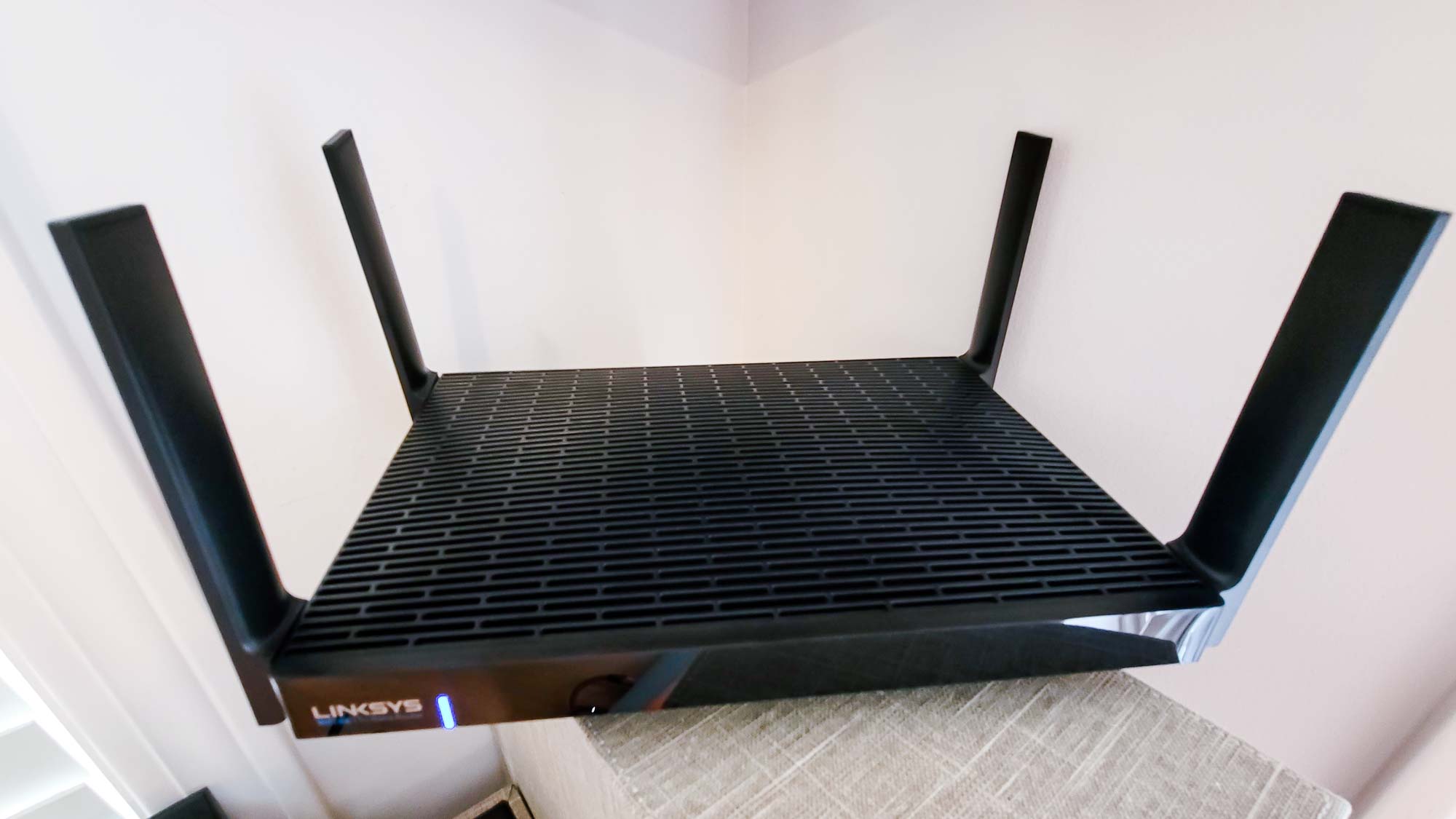
The entire top of the case is riddled with vents so that you can just about see the router’s components inside. While the Hydra 6E lacks the RAXE500’s cooling fan it never got above 118 degrees Fahrenheit – 6 degrees warmer than the RAXE500’s peak temperature.
As the first two Wi-Fi 6E routers, the RAXE500 and Hydra Pro 6E add a 6GHz band to the traditional 2.4- and 5GHz bands. The Hydra Pro 6E’s triband design can more than double the router’s data carrying capacity compared to a Wi-Fi 6 (802.11AX) device with six extra 160MHz ultra-wide data channels at its disposal in the 6GHz band. Look for WiFi 6E mesh routers that use a quad-band design in the coming months but there are only a handful of devices available that can take full advantage of the 6GHz transmissions.
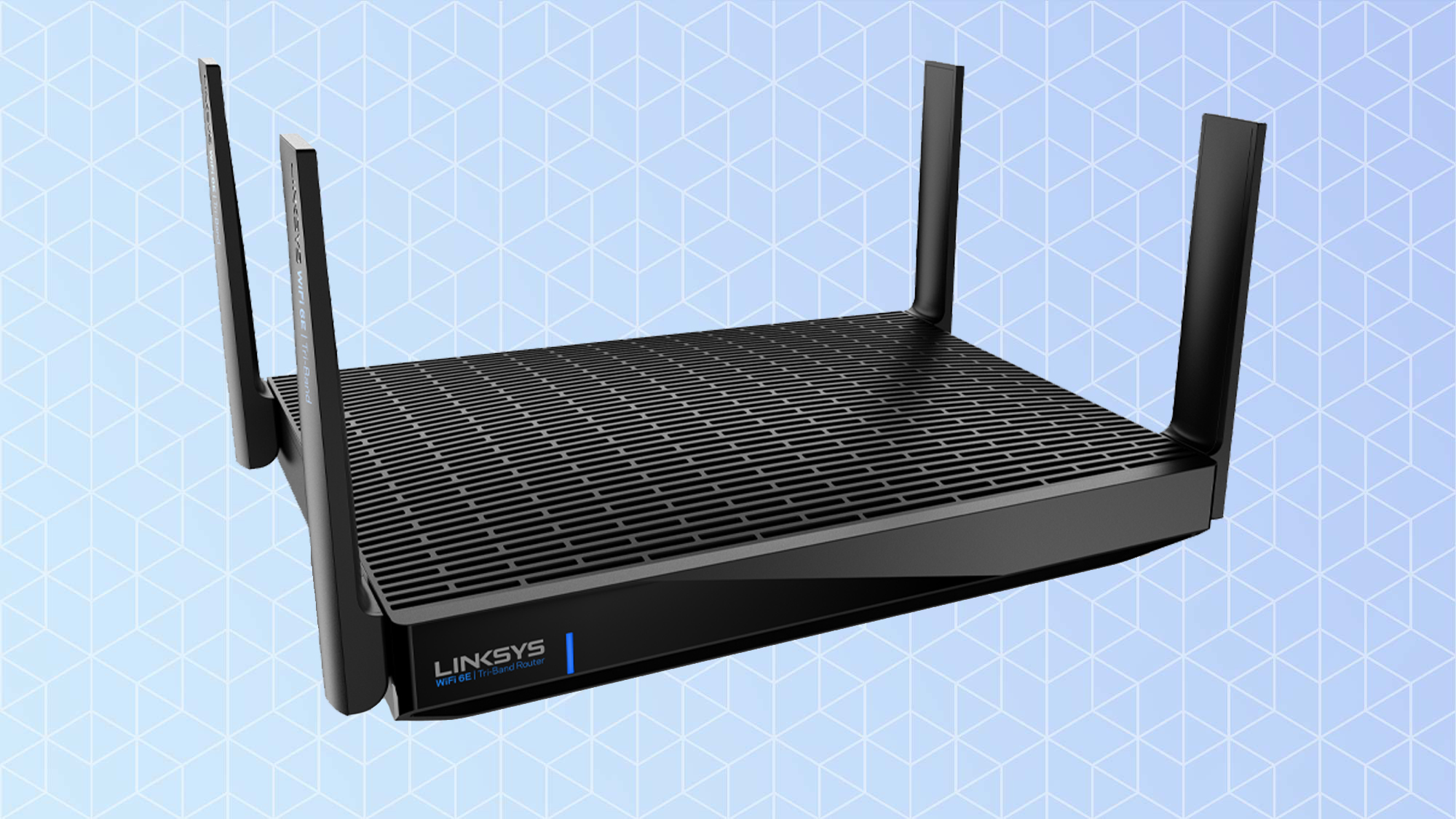
Linksys engineers based the Hydra Pro 6E’s design on Qualcomm’s Networking Pro 810 chipset, not the more capable and expensive 1210 chipset. This was done for economy and shows up with lower overall performance. With a rated peak throughput of 6.6Gbps, the 2.4-, 5- and 6-GHz bands are rated to move 600, 1,201, and 4,804 Mbps, respectively. By contrast, the RAXE500 can handle a maximum of 10.8Gbps.
Under the skin, the Hydro Pro 6E has a quad-core processor that runs at 1.8GHz and is stocked with 512MB of RAM as well as 512MB of flash to hold its firmware and settings. It checks all the boxes for an up-to-date router, including MU-MIMO, beamforming and 1024QAM operations. The router’s eight individual data streams can service up to 55 devices and Linksys rates its coverage area as 2,700 square feet.
The Hydra Pro 6E may be a mainstream router, but it has several high-performance tricks up its sleeve. Its 5Gbps WAN input port can help gamers seeking to rule the universe and can run circles around the Nighthawk RAXE500’s 2.5Gbps input – that is, if your broadband provider and hardware can support it. The router can also be used as part of a Velop mesh system using Linksys’ Intelligent Mesh software.
There are four downstream 1Gbps wired Ethernet ports, although none of them can be aggregated for extra performance. The Hydra 6E’s USB 3.0 connector can make the contents of an external hard drive available on the network.
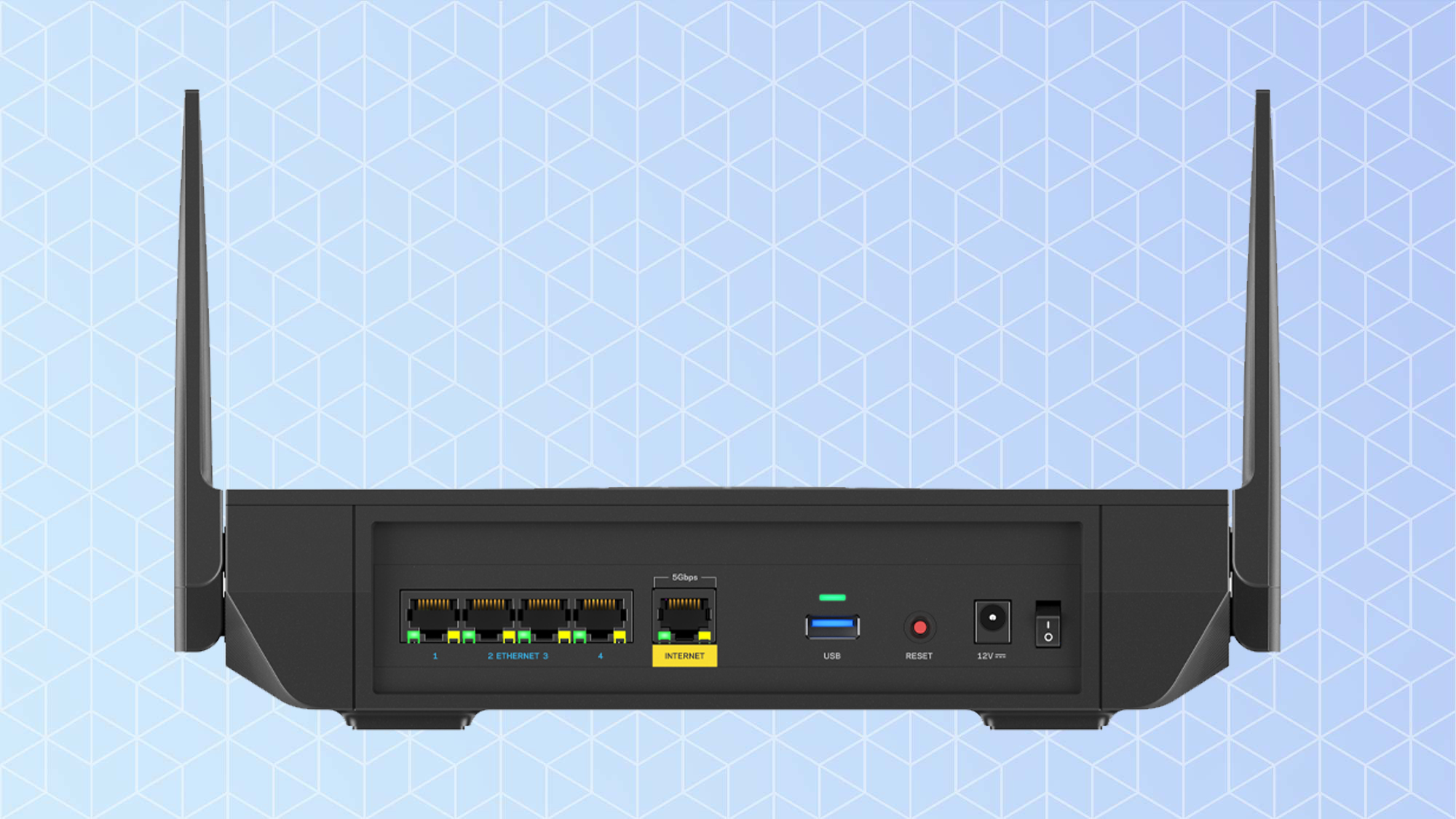
Along the back is an on/off switch, the router’s power port and a recessed reset button while the router’s side has a WPS button for tapping into the Wi-Fi Protected Setup to quickly add devices. Unlike other recent routers, the Hydra Pro 6E has a restrained appearance with a single LED bar that glows Blue (when it’s online), Purple (during setup) and Red (when offline).
Linksys Hydra Pro 6E review: Performance
The key to the Hydra Pro 6E’s performance is its addition of the 6GHz band to the expected 2.4- and 5GHz ones. To test the router’s performance I used Ixia’s ixChariot’s network simulation software to create a busy network that simulated 10 data-hungry users. The setup included a Samsung Galaxy Book Pro test computer running Windows 11 to gauge its performance potential.
At a distance of 15-feet, it yielded 1.064Gbps over the 6GHz band as well as 772.0Mbps and 122.7Mbps over the 5GHz and 2.4GHz bands. That adds up to a total potential throughput of 1.958Gbps, 20 percent off the RAXE500 (2.390Gbps), which was tested using a Samsung Galaxy S21 phone. Still, it tops the best Wi-Fi 6 routers, like the Netgear Nighthawk AX8 (1.389Gbps), Asus AX-RT86U (929.7Mbps) and the TP-Link Archer AX6000 (884.4Mbps).
With the three bands consolidated into a single network name and 50-feet separating the Hydra Pro 6E from the test system, the router moved 120.4Mbps. That’s behind the Netgear RAXE500 (215.8Mbps) as well as several older routers, like TP-Link Archer AX6000’s 396.4Mbps and the Netgear Nighthawk AX8’s 277.1Mbps.
At 75-feet, the Hydra Pro 6E’s available bandwidth dropped to 37.0Mbps, less than a quarter of the Netgear RAXE500 (148.6Mbps). The Hydra Pro 6E had a range of 80-feet, 30 percent lower than the Netgear RAXE500’s 105-feet. It clearly worked better at short range than over long distances.
The Hydra Pro 6E made up much of the difference when it came to pushing a Wi-Fi signal through walls and floors in my 100-year old home. With the test notebook set up 20-feet and a wall away from the router, it yielded an even 1.000Gbps, less than the 1.137Gbps that the RAXE500 delivered but impressive, nonetheless.
While the Netgear RAXE500 pushed 851.0Mbps up a floor into a bedroom from the host router, the Hydra Pro 6E fell behind at 620.1Mbps, a 37 percent deficit. Here, the Hydra Pro 6E was more on a par with the Wi-Fi 6 crowd with the TP-Link Archer AX6000 (671.4Mbps) and the Netgear Nighthawk AX8 (629.5Mbps). With that in mind, it might be better used in a long ranch house than a more vertical townhouse.
Over a month of daily use, the router passed the informal saturation test where I sent and received email, moved files back and forth with a RAID server while watching videos and playing online music and an Internet radio station on four different systems. Along the way, the Hydra Pro 6E consumed 10.4 watts of power, about one-third less than the Netgear RAXE500’s 15.4 watts. The Hydra Pro 6E, however, lacks the Netgear’s sleep mode to reduce power consumption when it’s idle. All told, the Hydra Pro 6E should cost an estimated $11.80 a year to use if you pay the national average of 13 cents per kilowatt hour. That’s slightly less than the Netgear RAXE500’s $13.70 but a lot compared to the Wi-Fi 6-based Linksys Max Stream MR9600’s $6.80.
Linksys Hydra Pro 6E review: Setup
To get started with the Linksys Hydra Pro 6E, I installed the Linksys iOS app on my iPad Pro. I could have used the Android app or a connected browser, although Linksys recommends the browser approach for experienced networkers.
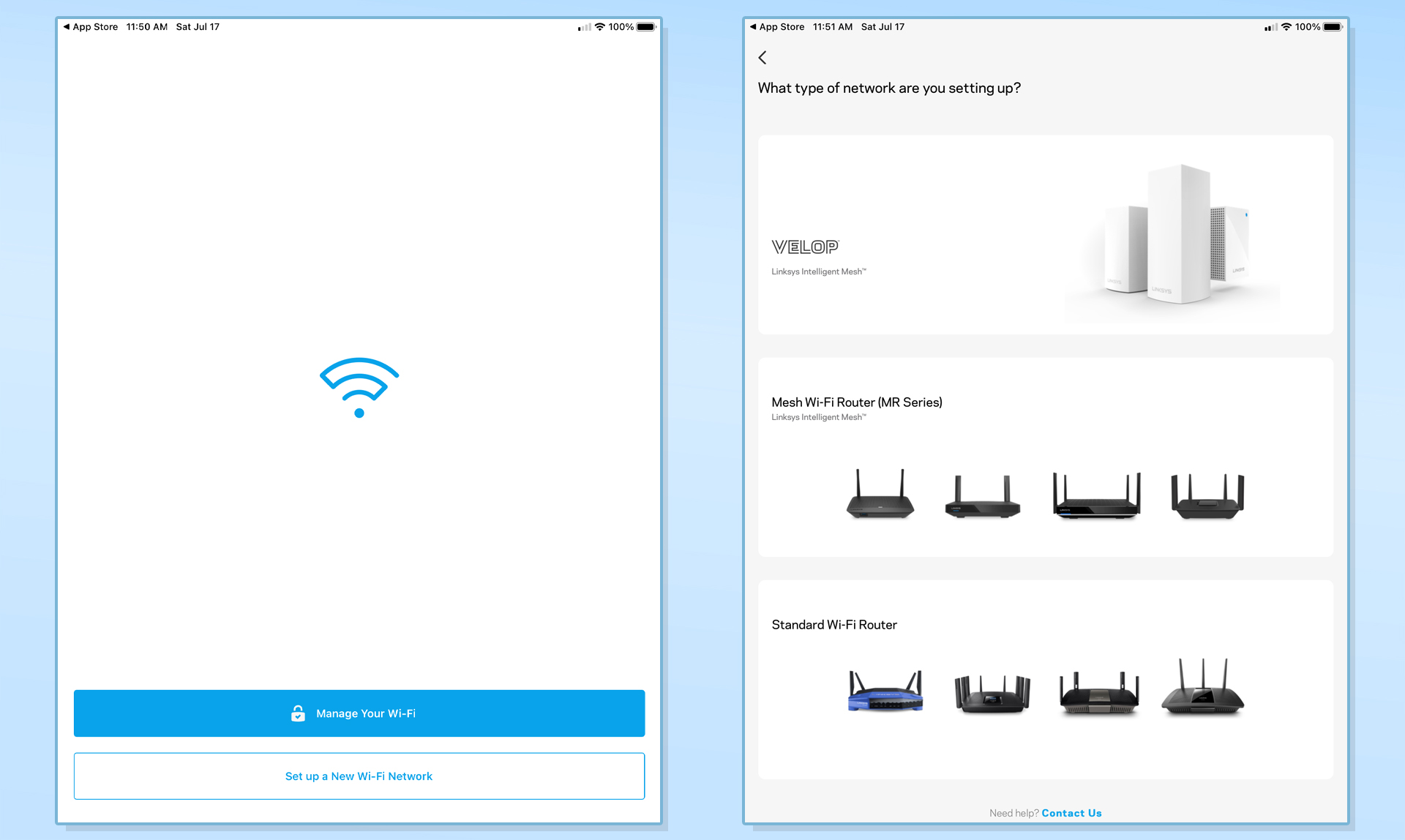
I started by tapping on “Set Up New Wi-Fi Network” and then agreeing to turn on the tablet’s Bluetooth radio. Next, I picked the type of gear I had, plugged the router in and connected it to my broadband router.
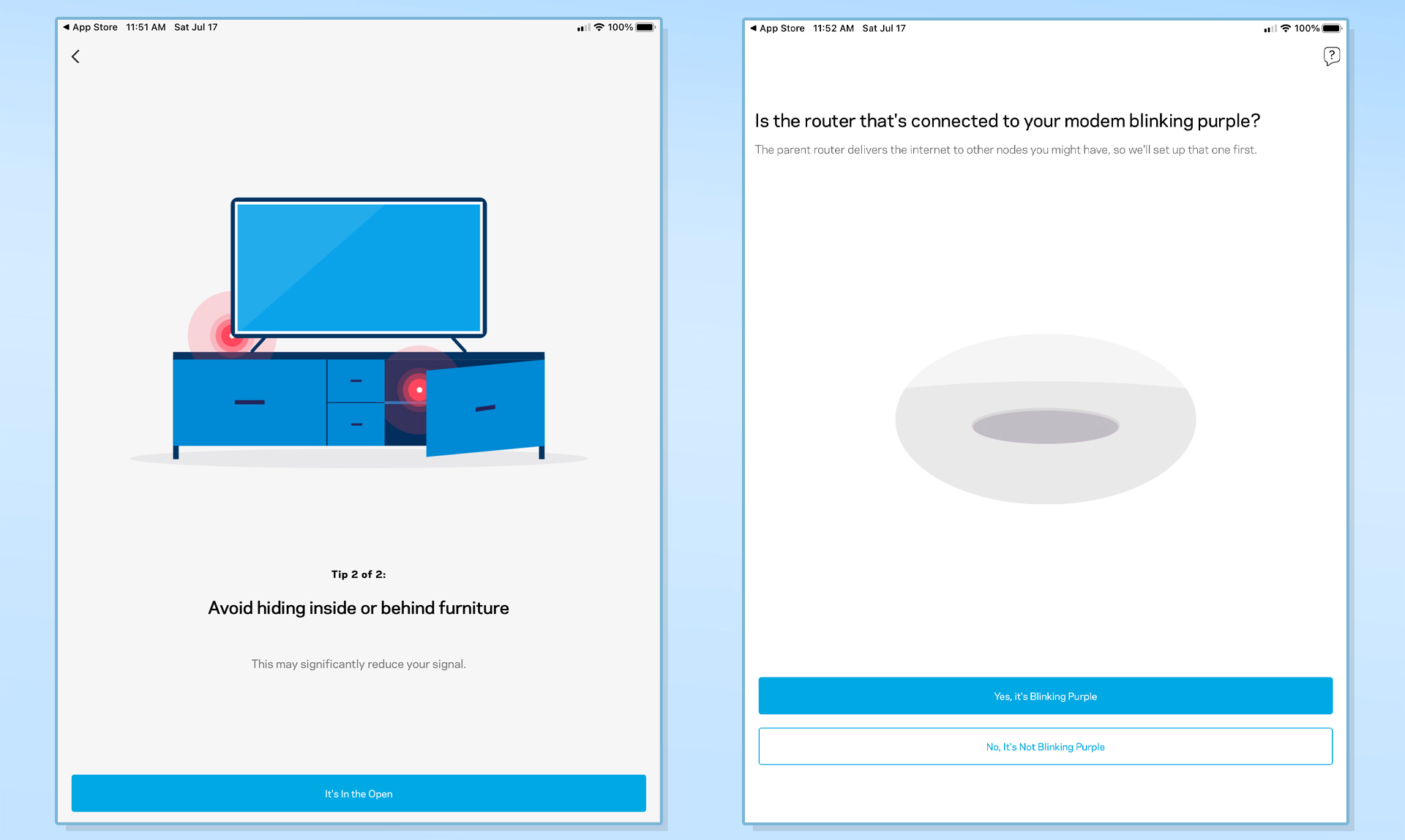
As it got going, the app showed router placement tips for best performance. After the Hydra Pro 6E connected to the Internet, the router’s LED bar blinked purple.

Next, I needed to create a Linskys account and allow the company to link the account and router. Then, I added the router’s network name and password.
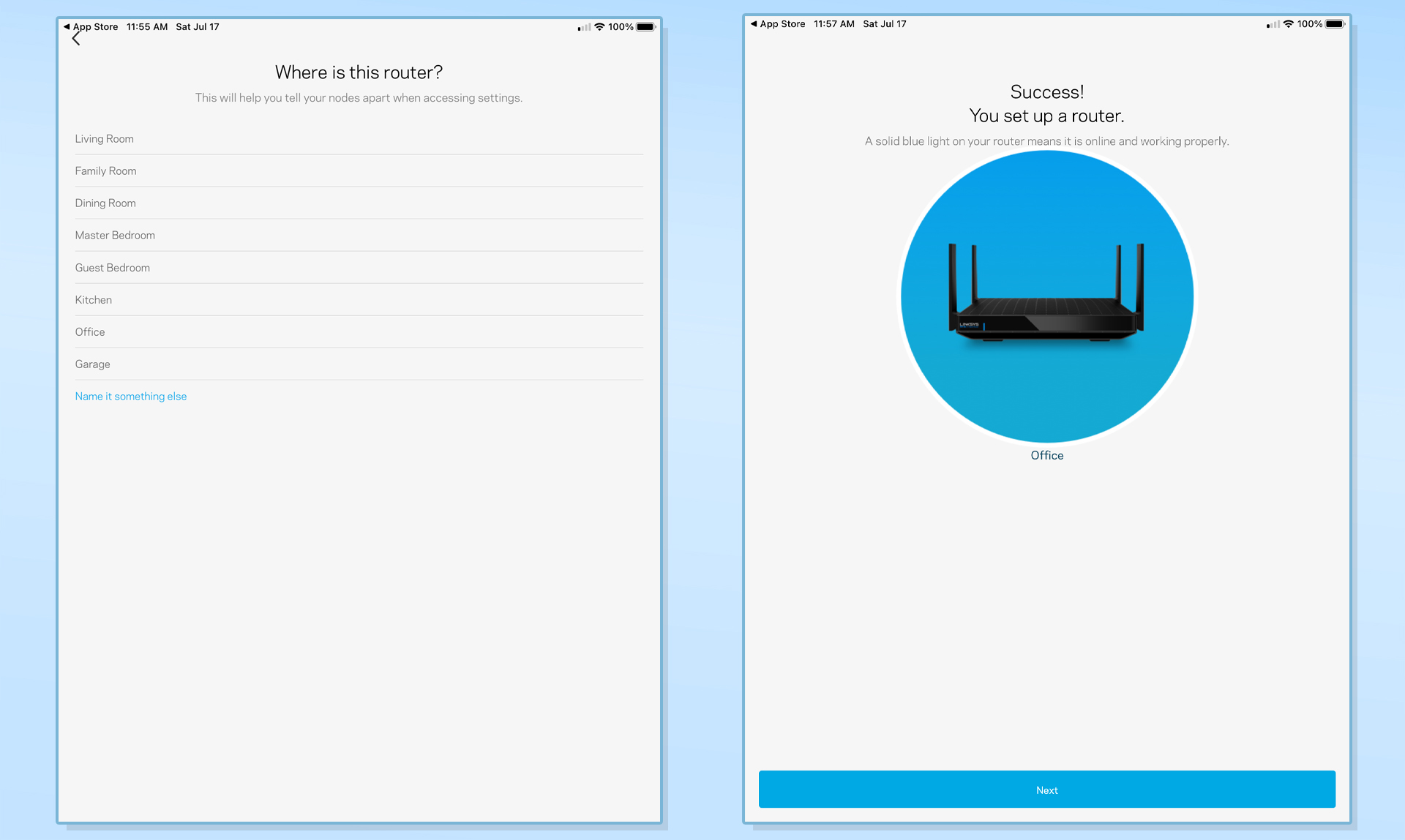
After I named where the router will live, I was done. The router connected on the first try. It was easier than setting up the Netgear Nighthawk RAXE500 and took all of 7 minutes to accomplish.
Linksys Hydra Pro 6E review: Configuration
Like many of its competitors, Linksys provides two ways to configure and customize its Hydra Pro 6E router: through the app or via a connected browser. The former is easy and visual while the latter provides several extra options.
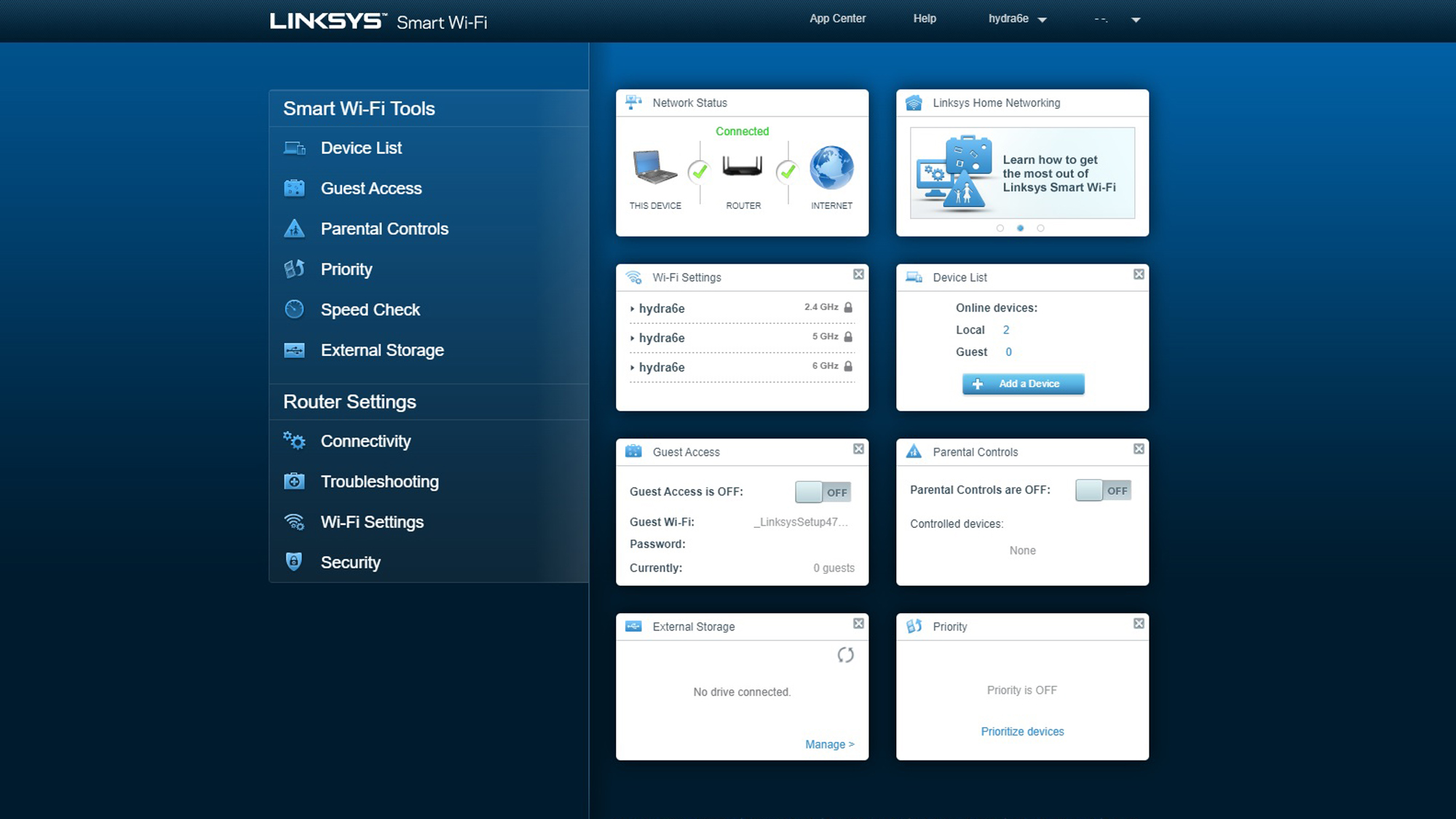
To view the current set up and make changes, I connected to the router, typed “LinskysSmartWiFi” into the address window and then logged in. The router’s dashboard page had a visual map of the Internet, router and my connected device. There are also sections that show the router’s three networks, which can be individually named, as well as places to show how many devices are online as well as the Guest Network’s status.
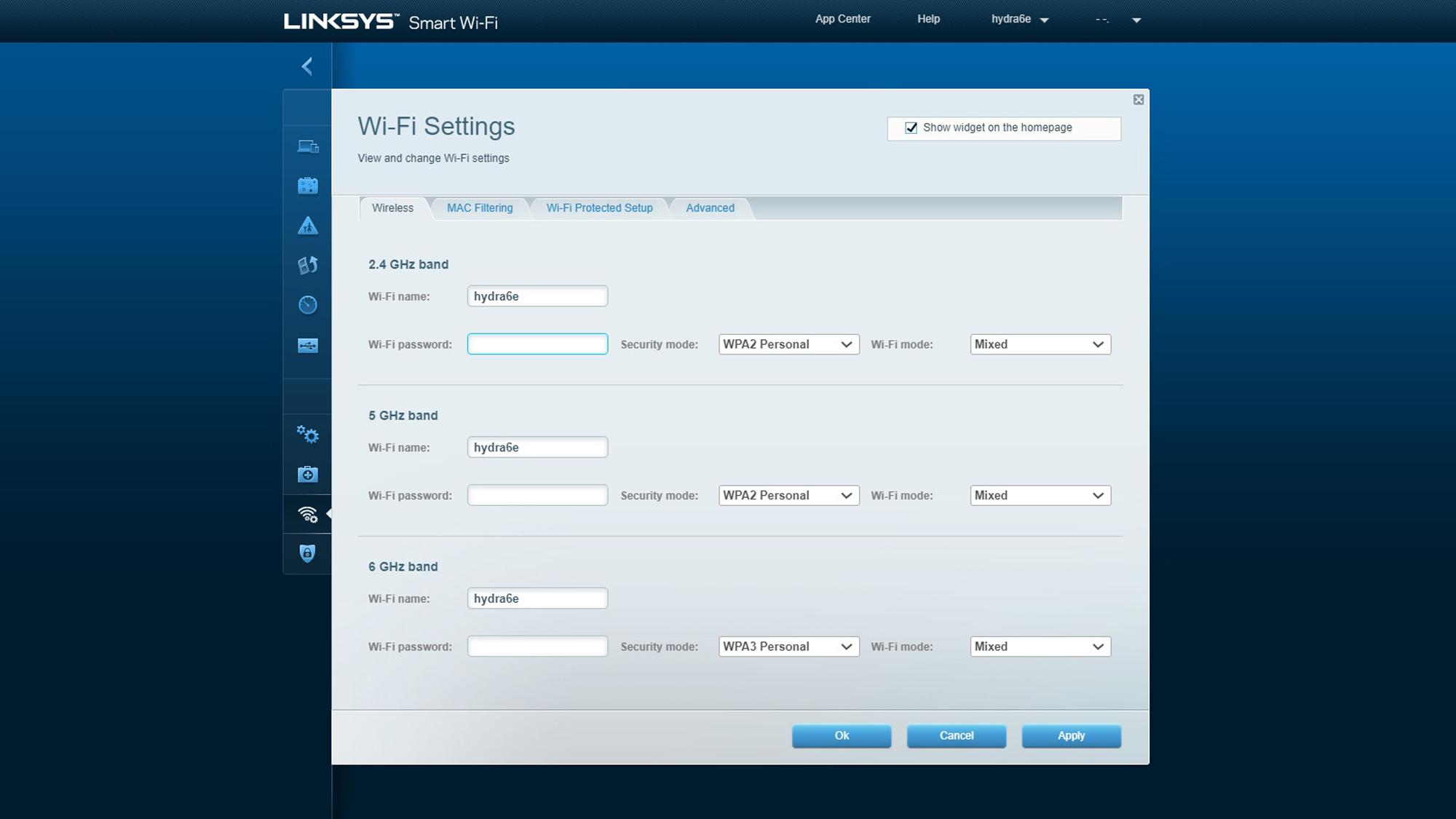
The router’s Wi-Fi Settings section is where I was able to change the network names and passwords for each of the Hydra Pro 6E’s transmission bands. Along the top are tabs for MAC filtering and Wi-Fi Protected Setup (WPS) details. The Advanced tab offers a good amount of customization potential, with the ability to adjust the airtime fairness, client steering and node steering.
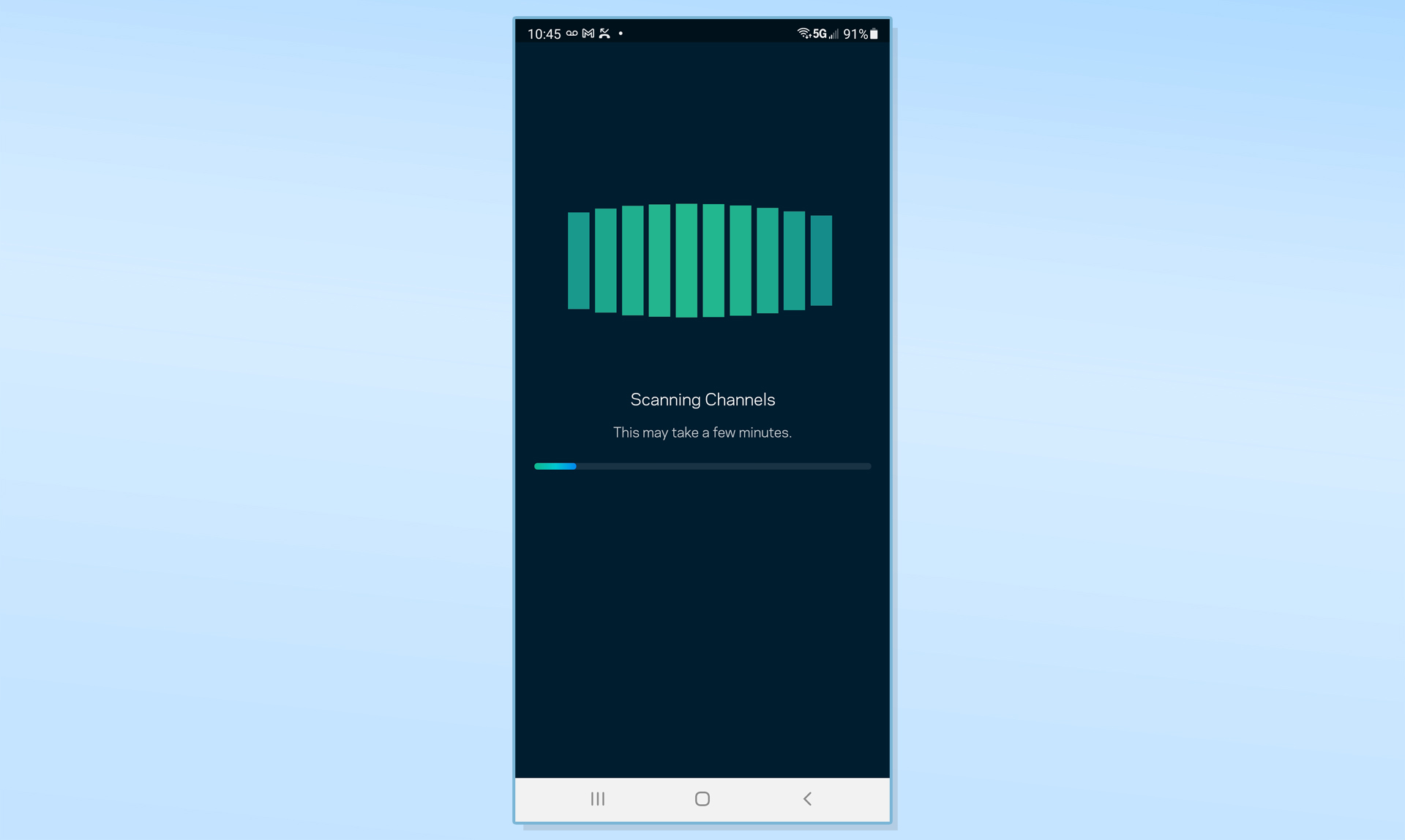
I found the Hydra 6E’s Channel Finder to be a big help in picking a fast lane for data. Located in the Advanced Wi-Fi Settings section, it scanned the Wi-Fi landscape and found the channels that were the least crowded and less prone to interference.
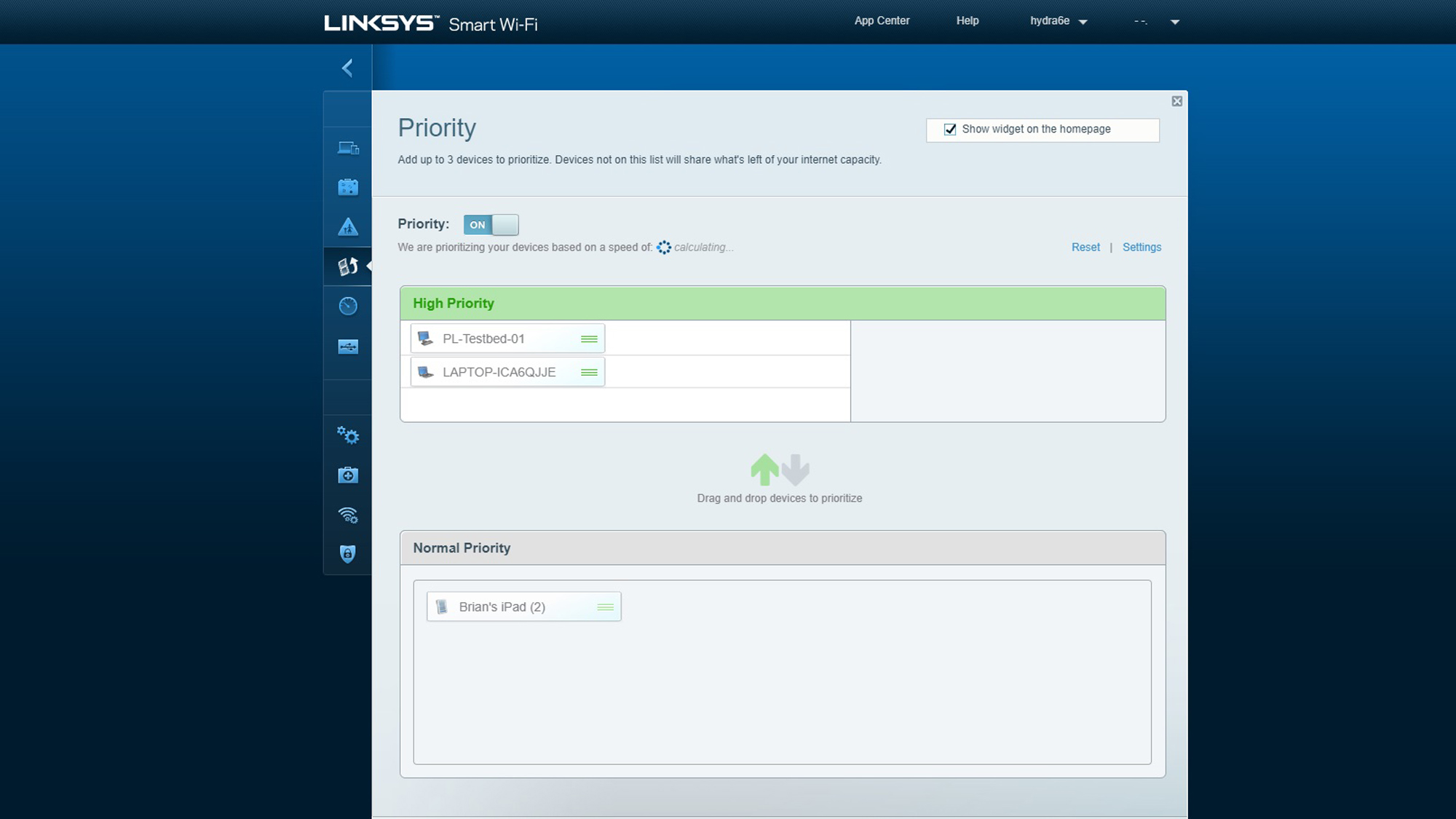
At the bottom is the place where you can take advantage of the router’s Quality of Service (QOS) settings to set priorities for the data flow. By dragging up to three devices, I was able to allow them to get first dibs on the router’s data.
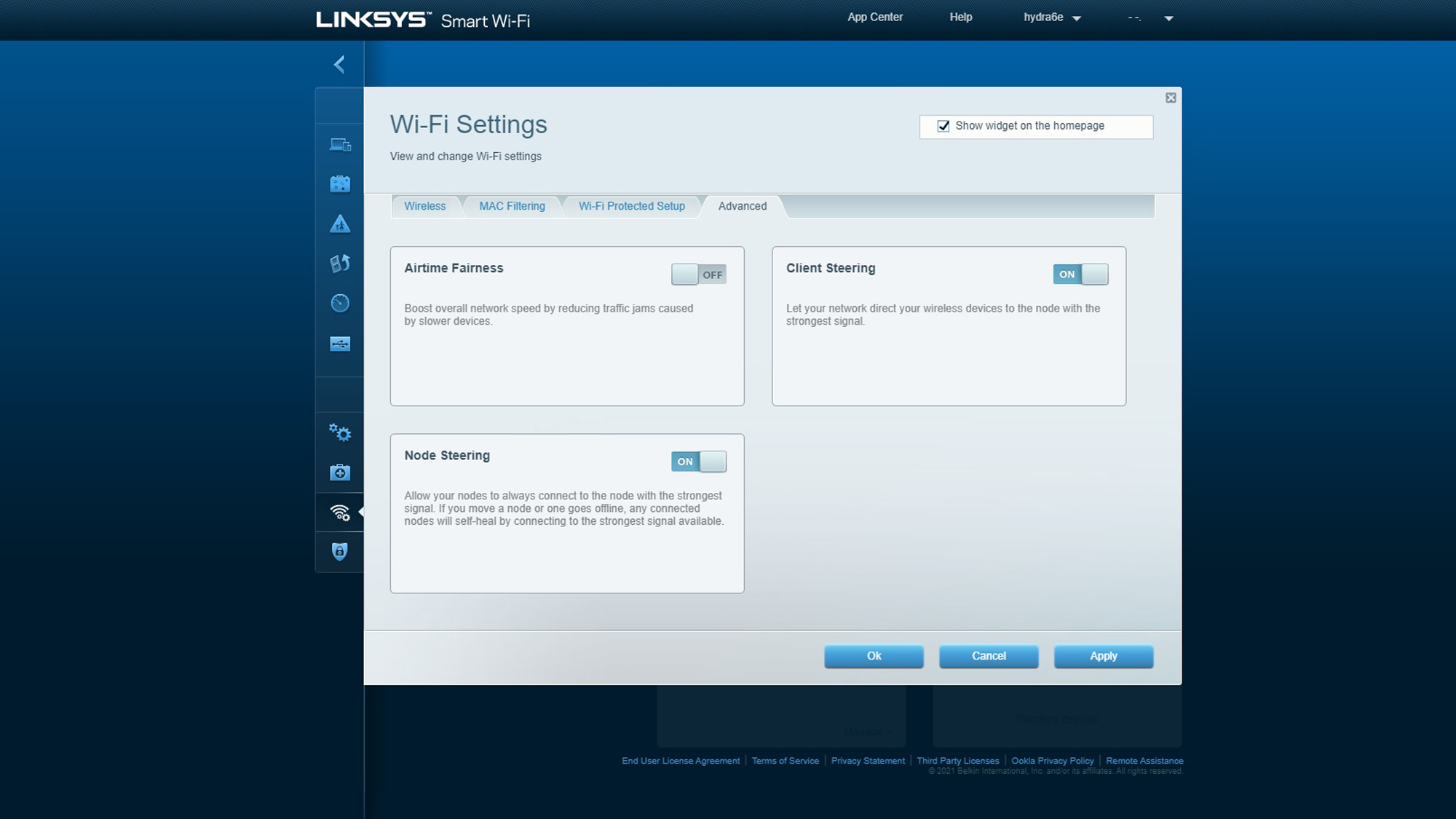
On the other hand, the Hydra Pro 6E lacks the flexibility to adjust the RTS Threshold but it’s easy to change the Fragmentation Length, pick between the long or short Preamble and change the Maximum Transmission Unit (MTU) to suit the operating conditions.
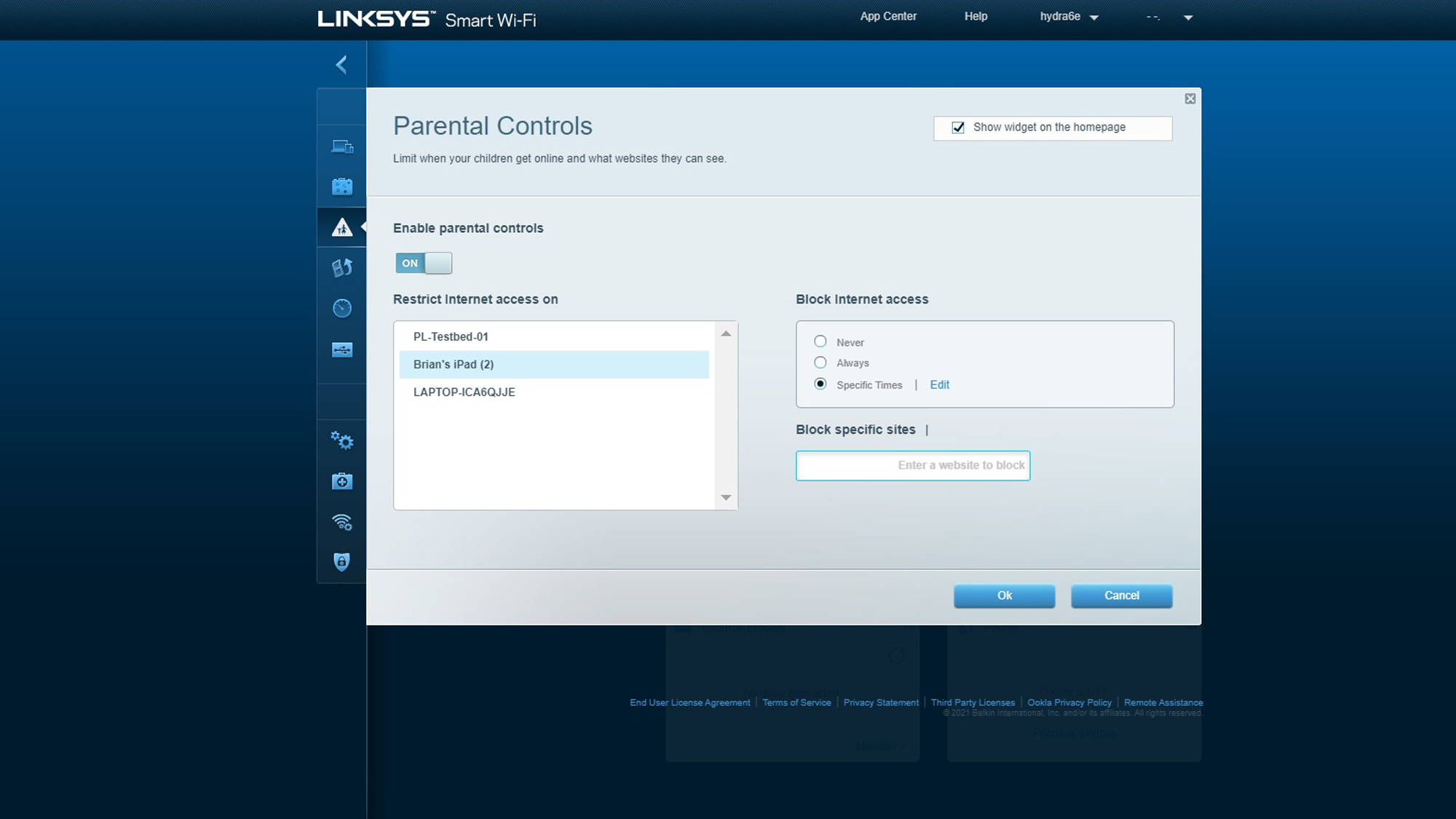
The Hydra Pro 6E lacks the security enhancements of Netgear’s Armor or TP-Link’s HomeCare, but it does come with parental controls that can limit Internet access time and block specific websites. It can also require the use of two-factor authentication.
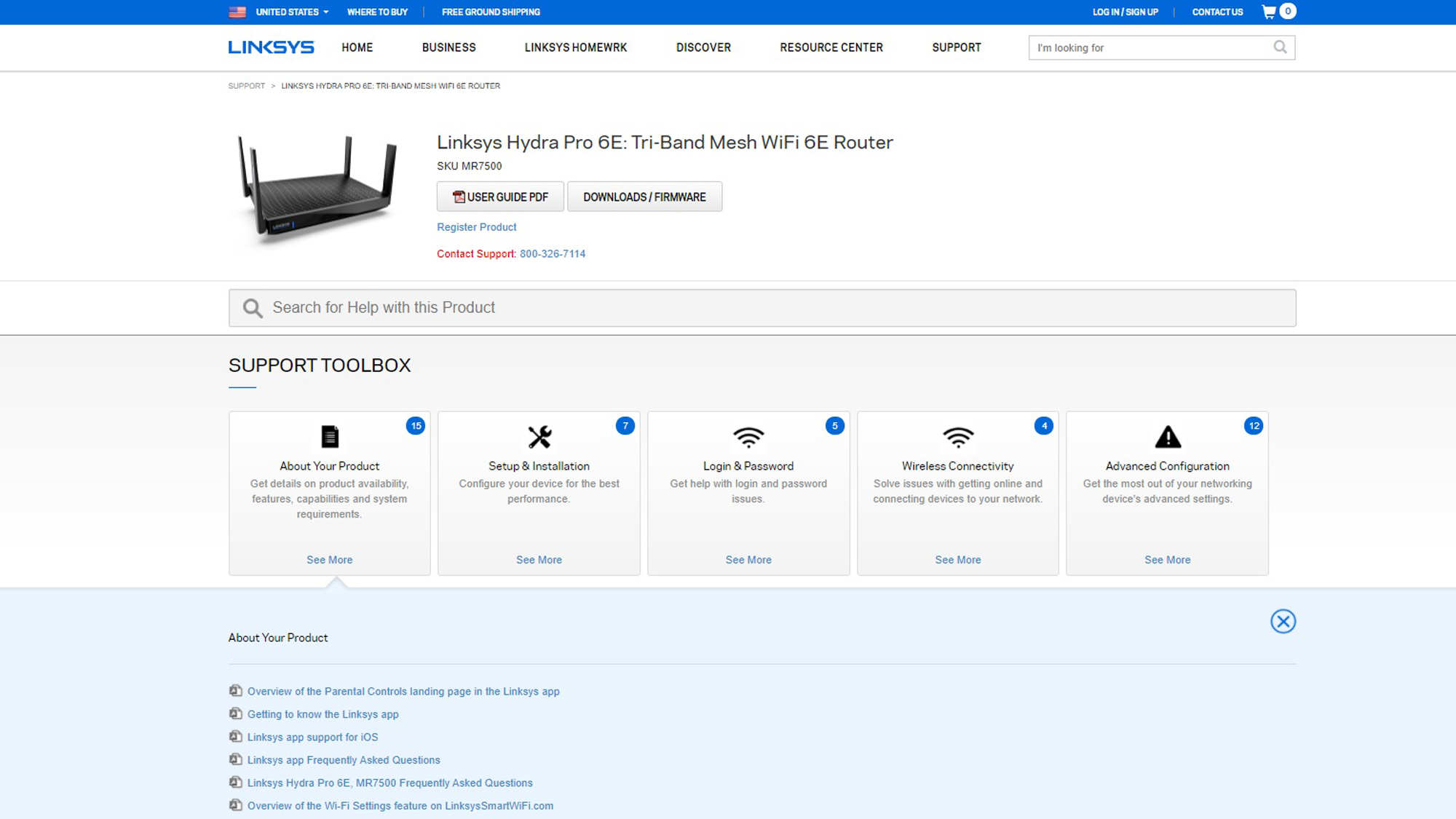
Finally, Linksys includes a year of warranty protection and support. The support pages include help with logging in, solving common Wi-Fi problems and some assistance with advanced configurations. By contrast, Netgear matches the warranty length but includes only three months of support.
Linksys Hydra Pro 6E review: Verdict
The Linksys Hydra Pro 6E makes high performance Wi-Fi 6E networking affordable with a mainstream router that pours out the power up close. It may not be the fastest router around or provide the greatest range, but the Hydra Pro 6E offers a quick setup, while delivering a significant speed upgrade over Wi-Fi 6 routers. Best yet, the Channel Finder technology scans the area to make the best use of the available spectrum.
The Linksys Hydra Pro 6E costs $100 less than the Netgear Nighthawk RAXE500, but falls short in most performance areas. It remains a less expensive way to take advantage of the addition of 6GHz transmissions, pushing the Hydra Pro 6E into a new performance realm.
For all the latest Technology News Click Here
For the latest news and updates, follow us on Google News.
